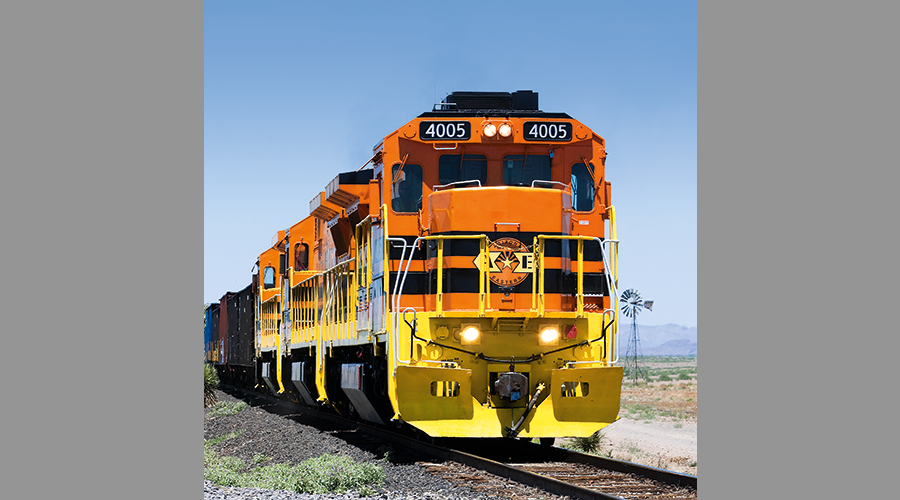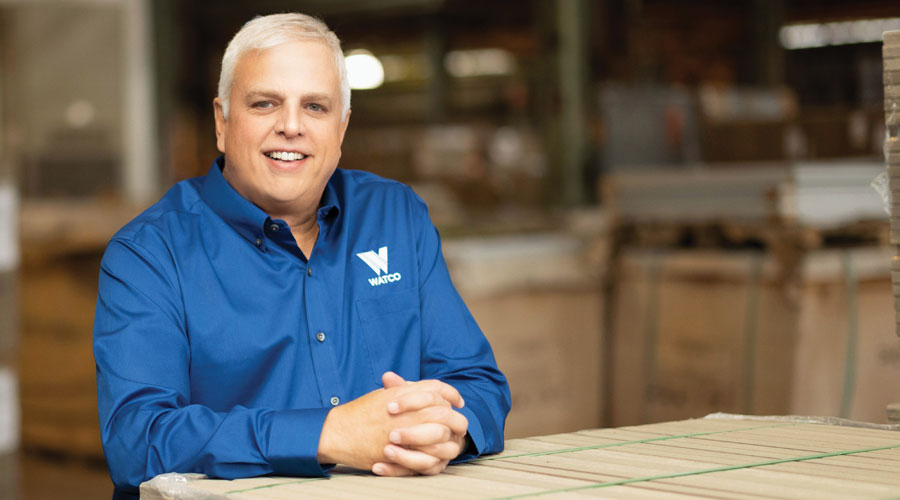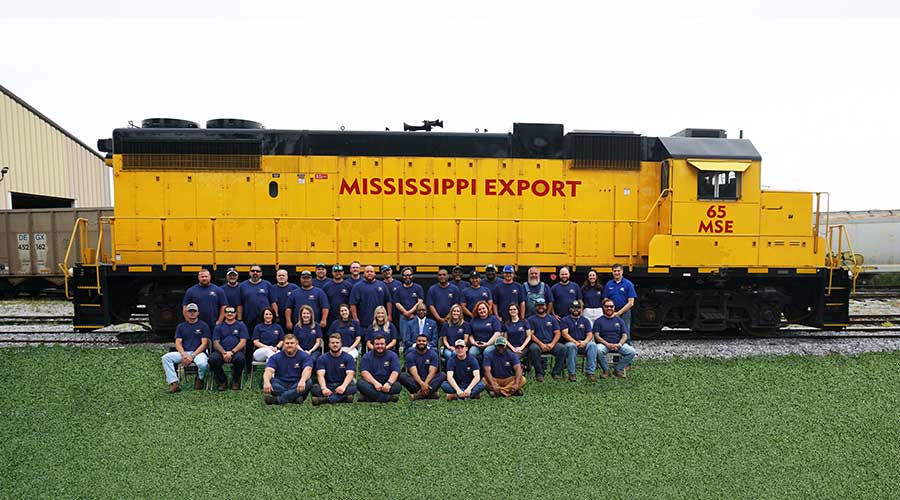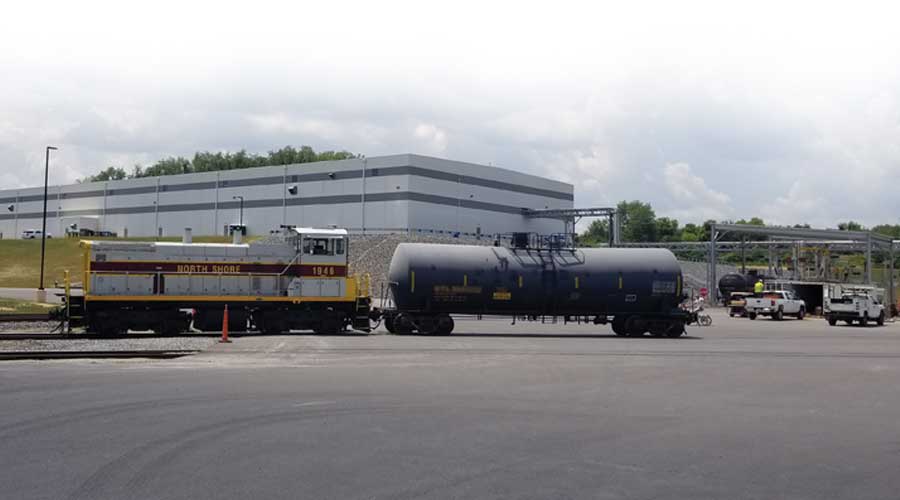Stay updated on news, articles and information for the rail industry
April 2014
Rail News: Short Lines & Regionals
Bryant family nurtures Buckingham Branch from small CSX branch line to growing railroad
— by Angela Cotey, senior associate editor
In 1987, at the age of 53, Bob Bryant bought a railroad.
He'd been a railroader for more than three decades, but wasn't fulfilling a dream of owning his own line. He didn't stumble upon a lucrative business deal that would yield millions. Bryant's reasoning was simple: It centered around a love for his community and close family ties.
Those values and others — hard work, integrity and respect for others among them — served as the foundation upon which the Buckingham Branch Railroad was built. They helped make it possible for the Bryant family — Bob, his wife Annie, son Mark and daughter Lois — to buy, then grow the central Virginia operation from a 17-mile CSX Transportation branch line to a 275-mile short line employing nearly 100 people, whom the Bryants treat as extended family. And they will remain key to ensuring the railroad continues to grow and succeed in the years to come.
"We try to follow our ideals. We very consciously keep these principles in front of us and we think that it makes for sound, stable business," says Mark Bryant, who today serves as the Buckingham Branch's chief executive officer.
The family patriarch knows a thing or two about the railroad business. Bob began working for the Chesapeake & Ohio Railway (C&O) in the early 1950s, the day after he graduated from high school, as a messenger in Richmond, Va. During his two years there, Bryant held positions as a stenographer, clerk and sorter operator, as well as in the freight planning department, before landing a job in the Columbia, S.C., sales department.
Bryant's rail career eventually led him to Baltimore in the early 1970s, when the C&O and Baltimore & Ohio (B&O) railroads consolidated their sales and marketing departments.
But Bryant and his wife intended to make their way back to the place they considered home: Virginia's Buckingham County. When the couple was in their late 20s, they purchased a farm there.
"My parents didn't vacation in France; they vacationed on the farm," says Mark Bryant, recalling days spent working there with his parents, aunts, uncles and cousins.
The Bryants planned on retiring on the farm, and they did — just sooner than expected. And with more than just the farm to keep them busy.
As the B&O and C&O railroads merged into what would become CSX Transportation, the Class I offered some employees an early retirement package. Bryant accepted the deal, but not before he convinced CSX finance officials to let him buy the Buckingham Branch.
"They were abandoning branch lines, and we knew about one in my home county that was on the list," says Bryant.
The Buckingham County branch line had special meaning to the Bryants; Bob's father had served as a brakeman and conductor on the line. And if it were abandoned, there would be no rail service to that part of the state.
"That really troubled my father," says Mark Bryant.
But CSX officials needed some convincing. They didn't believe the line could be profitable, and didn't want to be associated with a failed short line. So, Bob Bryant approached the line's potential customers, the largest being MeadWestvaco Corp., which owned a defunct wood yard on the line. The company had been using trucks to haul all its wood because the railroad had stopped providing short-haul wood services. MeadWestvaco officials told Bryant they would support his acquisition of the railroad because they "didn't want all their [transportation] eggs in one basket," he says.
MeadWestvaco officials put their commitment in writing, and Bryant was able to take it to CSX and a local bank to finalize the sale. Bob and Annie bought the railroad for less than $100,000, although they invested additional dollars to repair infrastructure and purchase equipment.
The couple delved into their new career as railroad owners. Annie, a former teacher, handled the finances, while Bob set out to learn the ins and outs of operating a short line. For starters, he hired his first two employees: Jack Yowell, an engineer who also had taken the CSX buyout, and Michael Pace, a former C&O track department worker. The men operated trains three days a week and completed trackwork on the remaining days.
Bob and Annie soon enlisted the help of their son. At the time, Mark was in his early 30s and living in Richmond, where he worked as an artist, painting water-based media on paper. Bob and Annie offered him part-time work at the railroad, where he served as a freight agent, car hire accountant, and third-string engineer and conductor.
"In the early days, we all wore a lot of hats," says Mark, who spent his days off from the railroad either in a studio painting, or attending art exhibits.
Working On The Railroad
These days, the railroad is a full-time job for Mark, now 56, who was named president in 2009 and CEO, in 2011. The railroad marked its 25th anniversary in March, and during the past quarter-century, the Bryant family has poised the railroad for growth, which it has attained through two leases with Class Is, as well as by seeking out new customers and business opportunities.
"We've grown in pretty significant ways, and that's required more of my attention here," says Mark Bryant, who continues to paint in his spare time. Still, it's clear the railroad is the priority: "This business is in the family's blood, and we put a pretty high value on that."
They put a pretty high value on workers, too, Mark adds. From the Buckingham Branch's inception, the Bryants have had a policy to provide full-time work to employees. If business slows, managers might temporarily reassign a conductor to another crew, have an engineer help with track maintenance, or ask someone to cut the grass.
"We always find something for them to do, so our employees can be assured a regular paycheck," says Bob Bryant.
Buckingham Branch officials also believe they offer competitive wages and a benefit package tailored to meet the needs of their employees. They also offer an annual bonus program. All of the Buckingham Branch's profits are reinvested, either in the infrastructure or employees.
"They share in the success of the company. Our people are what make the railroad," says Bryant.
Today, there are 98 of them. As business has grown, the short line has steadily increased its workforce. And a partnership with the commonwealth of Virginia helped put the railroad on the growth track.
In the early 1990s, the commonwealth launched a rail preservation grant program; state transportation officials didn't want any more short lines to be abandoned. The commonwealth approached Bryant about applying for a grant, but he declined.
"I was worried that if we took their help, they would try and tell us how to do things," he says.
But a year later, Bryant decided revenue levels weren't high enough to cover trackwork that needed to be done.
"I had this vision of grass and weeds growing up, ties decaying, and one of our locomotives rolling off the track and into the Slate River," he says. "I figured we should rethink our program."
So, the Buckingham Branch accepted a 70/30 matching grant of about $100,000 to replace ties. It was the first of several grants the short line would receive from the commonwealth to maintain its infrastructure, including a wayside signal system replacement, bridge work, and rail replacement.
Buckingham Branch business
With the improved infrastructure and a few employees added to the roster, the Buckingham Branch continued to serve customers that, in addition to MeadWestvaco, included Kyanite Mining, a Koppers tie facility, a lightweight aggregate manufacturer and a slate quarry.
By the early 2000s, the railroad was handling about 2,000 carloads annually, says President Steve Powell, who joined the railroad 15 years ago as assistant to the president.
A mechanical engineer by education, Powell worked for Goodyear for 10 years until the Richmond native decided he would prefer to work for a small, privately owned company. Powell's father, Don, was a former CSX marketing executive who had worked with Bob Bryant for many years, and put the men in touch. Bryant's growth plans for the railroad, personable nature and business philosophies intrigued Powell.
"He's a man of vision and quiet passion. He believes in investing in your infrastructure and investing in your people — without that, you'll never get another customer," says Powell.
During the interview process, Bryant shared some of his ideas with Powell. They included the possibility of the Buckingham Branch someday operating CSX's 200-mile Washington Mountain subdivision, as well as Norfolk Southern Railway's Virginia Southern Division.
In the early 2000s, the first of those two prospects was set into motion. CSX invited about a dozen of its short-line partners to bid on a proposal to operate a 200-mile line between Richmond and Clifton Forge, Va. Four short lines submitted proposals to operate the line, which was "challenged" and had a "fairly small" customer base, says Powell.
Knowing they could obtain a grant from the commonwealth to maintain track, Buckingham Branch officials bid to lease the line — and included a stipulation. CSX was operating a large number of empty coal trains across the route. If the Class I continued to do so — and paid the short line trackage rights for the overhead empties — Buckingham Branch officials figured they would have a strong enough revenue stream to operate the line successfully.
CSX selected the Buckingham Branch's proposal and in late 2004, the short line began operating what is now known as the Richmond & Alleghany (R&A) Division. The railroad went from operating 17 miles of track with 13 employees, to operating 217 miles of track with 54 employees. Carloads grew to about 12,000 annually. The transition was smooth, Powell recalls, but it did "make us grow up real fast."
For example, the short line needed to create formal track, transportation, mechanical, administrative, human resources, marketing, signal, and dispatching departments.
Bob Bryant also hired someone to handle business development, recruiting Pilgrim's Pride executive Gale Wilson for the job. Wilson had experience building feed mills, purchasing commodities and securing rail transportation for the poultry company. At one point, he contracted the Buckingham Branch to operate a short line that served one of the poultry company's plants.
"Bob was very interested in having a key management position filled by someone with a customer background who also had dealt with railroads," says Wilson, who today serves as the short line's senior vice president.
On The Growth Track
Since acquiring the R&A division, the Buckingham Branch has added eight new customers. Traffic commodities include pellets, wood, coal, newsprint, fertilizer, feed ingredients and cement. Between 2004 and 2009, the Buckingham Branch almost doubled traffic levels on the R&A division.
Wilson attributes the traffic jump to good customer service and competitive rates. CSX had been providing weekly service to some customers on the line; when the Buckingham Branch took it over, the railroad began offering service five days a week. The short line also works with customers to help them develop new business. The railroad would like to double traffic on the R&A once more, says Powell.
"If you become stagnant, you're not successful for very long," adds Wilson.
Buckingham Branch officials hope to grow traffic on the Virginia Southern Division, as well. The short line began leasing the 58-mile line from NS in 2009. It runs from Burkeville to the North Carolina state line.
"It's a challenged line. The primary customer is a coal-fired power plant, and we all know what's happened to coal-fired power plants," says Powell.
The Buckingham Branch also serves a chip mill on the line, and soon will begin serving a new Patriot Rail Co. rail-car repair facility.
"We do see the potential for increased business here. There is land available that could be developed for business and industry," says Wilson.
In the meantime, Buckingham Branch officials continue to work with commonwealth and local economic development groups, as well as site consultants seeking new areas to locate businesses.
Buckingham Branch execs also are pursuing transload business. In the past year, the railroad has secured contracts with Nestle-Purina PetCare Co. and Sunoco Inc. Wilson is working to secure two additional transloaders.
"We think there are opportunities in commodities such as feed ingredients, food ingredients and consumer products," says Powell. "They move a lot smaller volume, but we feel we could handle a lot of different customers."
Buckingham Branch officials also will continue to examine opportunities to lease additional track.
"We have four different railroads we're looking at right now, but the merit isn't there yet," says Powell. "We'll stay in contact with potential customers and if we can develop a business plan, we can try and make a run."
All In The Family
Regardless of how much the Buckingham Branch has grown over the years — or might continue to in the future — customers and employees can count on the Bryants to keep operating the small road with a small-business feel, the family members say.
Bob and Annie are gifting the railroad to Mark and his sister, Lois Frank, who lives in Maryland, but serves on the Buckingham Branch's board and stays up to speed on the family business. The siblings plan to keep the railroad privately operated and family owned.
While Bob has started spending more time on the farm, he remains heavily involved in the railroad. He keeps a pulse on the commonwealth and local politics that could impact the business, and continues to work on business development. You also might find him sweeping floors or hauling equipment to crews, says Mark.
A third generation of Bryants are entering the Buckingham Branch ranks. Frank's son, Kyle, recently graduated from the University of Scranton with a degree in psychology, philosophy and human resources, and is performing human resource work at the Buckingham Branch.
"From our perspective, that's a great place for him to start," says Mark. "The railroad starts with the people."
It's a philosophy that Bob Bryant has passed on to his children and employees, along with a few others that have served the railroad well.
"My parents have devoted their lives to work — not as drudgery, but as something they find invigorating," says Mark. "It's a real inspiration."
Keywords
Browse articles on Buckingham Branch Railroad Bob Bryant Mark Bryant Steve PowellContact Progressive Railroading editorial staff.


 2025 MOW Spending Report: Passenger-rail programs
2025 MOW Spending Report: Passenger-rail programs
 Gardner steps down as Amtrak CEO
Gardner steps down as Amtrak CEO
 Guest comment: Oliver Wyman’s David Hunt
Guest comment: Oliver Wyman’s David Hunt
 Women of Influence in Rail eBook
Women of Influence in Rail eBook
 railPrime
railPrime







